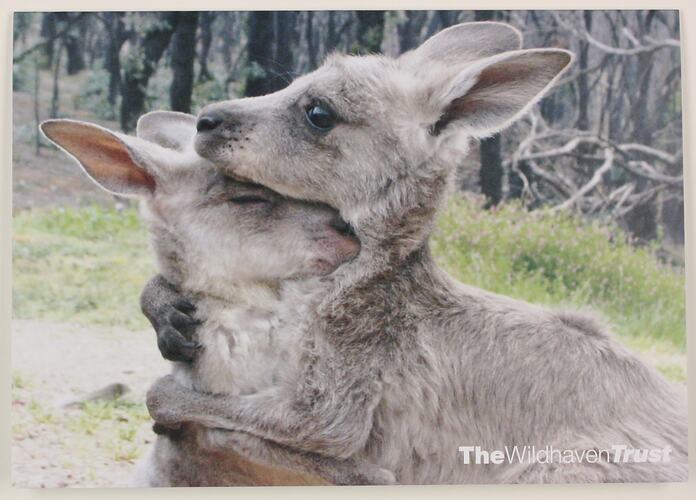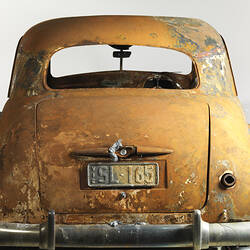Summary
This gift card is part of a series of five gift cards developed by Stella and Alan Reid to promote the the Wildhaven Wildlife Shelter. Each card features animals that have been rehabilitated at Wildhaven; the photographs were taken by Stella at Wildhaven and show the burnt environment following Black Saturday. It is one of two cards featuring Merlot and Cooper.
The orphaned joeys, Merlot and Cooper were the first animals that Stella and Alan cared for following Black Saturday. They were offered to Wildhaven in August and September 2009, as other wildlife shelters were at capacity; both were orphaned due to car accidents that killed their mothers. This powerful image of Merlot and Cooper hugging has been featured in exhibitions, publications and the internet.
Alan and Stella Reid live adjacent to the Kinglake National Park. They created 'Wildhaven' in 1998, as a refuge and rehabilitation centre specialising in kangaroos, wallabies and koalas. The Black Saturday bushfires destroyed everything on their property, all of the animals in their care were killed, and their home and other buildings were razed. Stella is a member of the St Andrews CFA and was on active duty during the day; she witnessed her home go up in flames from across the valley. Alan, who was at home when the fire struck was lucky to escape without injury. The fire killed twelve of their neighbours, the 40-50 animals in their care, hundreds of animals in the surrounding properties, and (according to their estimate) up to 90% of the wildlife in Kinglake National Park.
Physical Description
Folded gift card with colour image of two joeys (baby kangaroos) hugging against background of burnt trees and new grass.
Significance
This item is part of a collection relating to the experiences of Alan and Stella Reid following the devastating impact of the Black Saturday bushfires. In particular it helps provide insights into the community response through the variety of gifts and donations provided to survivors of the bushfires and the ideas of the types of needs they represented.
More Information
-
Collection Names
-
Collecting Areas
-
Acquisition Information
Donation from Ms Stella Reid - Wildhaven Wildlife Shelter, Mr Alan Reid, 08 Aug 2012
-
Place Named
Wildhaven Wildlife Shelter, St Andrews, Victoria, Australia, After Feb 2009
-
Inscriptions
Front cover: 'The Wildhaven Trust'.
-
Classification
-
Category
-
Discipline
-
Type of item
-
Keywords
Bushfires, Emergency Services, Rural Victoria, Rural Women, Volunteers, Wildlife, Wildlife Rescue

